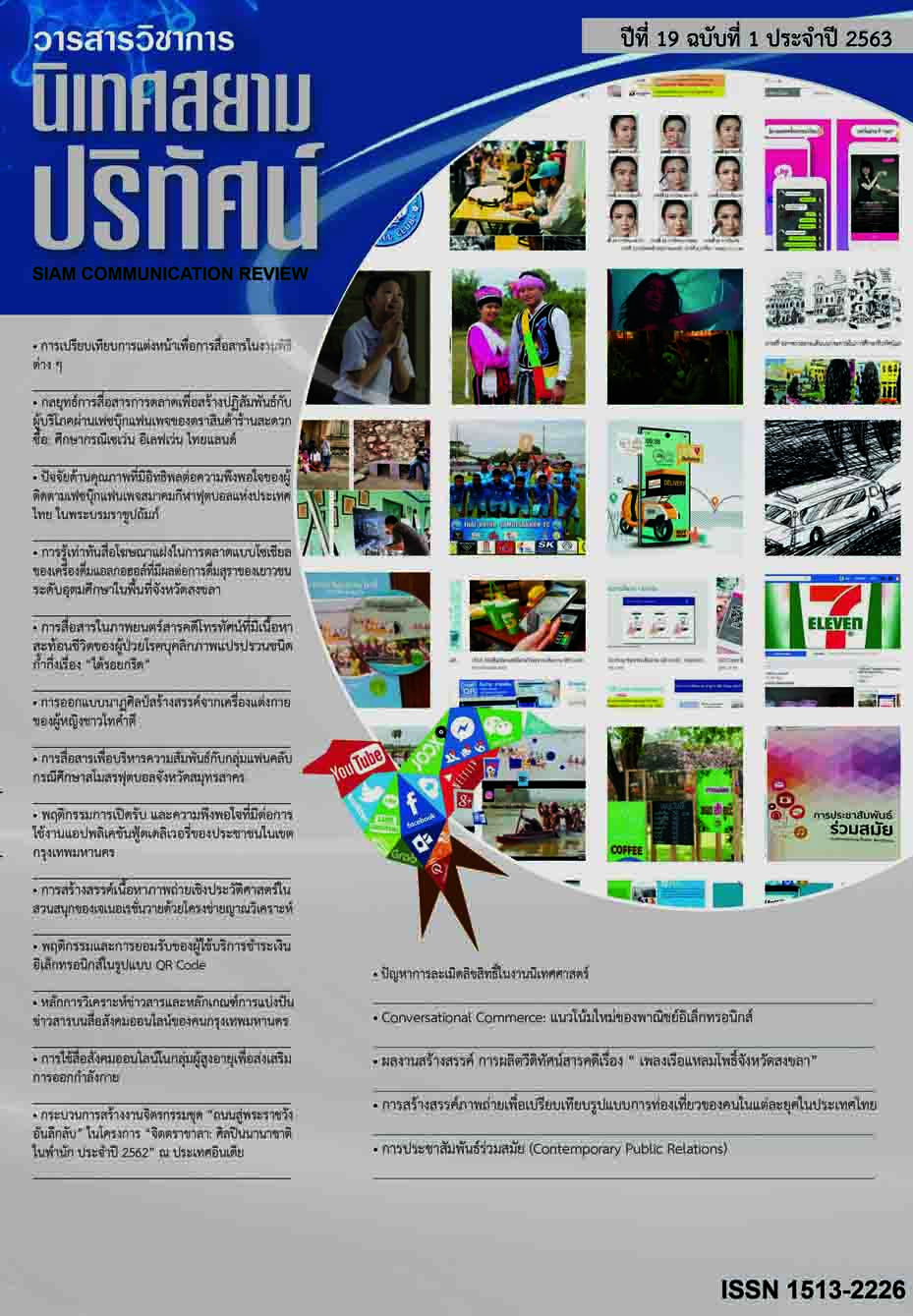Quality Factors that Influence Satisfaction of the Football Association of Thailand under Patronage of His Majesty the King Facebook Fanpage Followers
Main Article Content
Abstract
The study aims to explore how the different quality dimensions affect the social media users’ satisfaction and to study quality factors that influence user satisfaction of FA Thailand Facebook fanpage followers. The research was designed as quantitative study. Non-Probability Sampling (Accidental or Haphazard Sampling) was used in this study. The sample of this research is 400 who were FA Thailand Facebook fan page follower. We used a web survey tool and online surveys were created as web forms with a database to store the answers and statistical software to provide analytics. The results showed that the service quality of FA Thailand Facebook fan page was perceived as “Agree” (X̄ = 3.59), the information quality of FA Thailand Facebook fan page was perceived as “general” (X̄ = 3.40) and the system quality of FA Thailand Facebook fan page was perceived as “general” (X̄ = 3.42). The results showed that information quality has the strongest influence on user satisfaction toward the use of FA
Thailand Facebook fan page, followed by service quality and system quality respectively, with statistical significance at the level of 0.05.
Article Details
References
Boyd, D. M., & Ellison, N. B. (2007). Social network sites: Definition, history and Scholarship. Journal of Computer-Mediated Communication, 13(1), 1-21.
Braunstein, J. R., & Ross, S. D. (2010). Brand personalityin sport: Dimension analysis and general scaledevelopment. Sport Marketing Quarterly, 19(1), 8-16.
Davis, L., & Jackson, B. (2005). Acquiring, Implementing, and evaluating information technology. Thousand Oakes: Sage.
DeLone, W. H., & McLean, E. R. (1992). Information systems success: The quest for the dependent variable. Information Systems Research, 3(1), 60-95.
DeLone, W. H., & McLean, E. R. (2003). The DeLone and McLean Model of Information Systems Success: A Ten-Year Update. Journal of Management Information Systems, 19(4), 9-30.
Doherty, N., & King, M. (2004). The treatment of organizational issues in systems development projects: the implications for the evaluation of information technology investments. Electronic Journal of Information Systems Evaluation, 4(1), 1.
Grove, S. J., Pickett, G. M., Jones, S. A., & Dorsch, M. J. (2012). Spectator Rage as the Dark Side of Engaging Sport Fans: Implications for Services Marketers. Journal of Service Research, 15(1), 3-20.
Hunt, K. A., Bristol, T., & Bashaw, R. E. (1999). A conceptual approach to classifying sports fans. Journal of Services Marketing, 13(6), 439-452.
Hur, S. J., Lim, B. O., Decker, E. A., & Mcclements, D. J. (2011). In vitro human digestion models for food applications. Food Chemistry, 125(1), 1-12.
Kaynak, E., Salman, G. g., & Tatoglu, E. (2008). An integrative framework linking brand associations and brand loyalty in professional sports. Journal of Brand Management, 15(5), 336-357.
Keenan, A., & Shiri, A. (2009). Sociability and social interaction on social networking websites. Library Review, 58(6), 438-450.
Koetsier, J. (2013). Facebook: 15 million businesses, companies, and organizations now have a Facebook page. San Francisco, CA: VentureBeat.
Mangold, W. G., & Faulds, D. J. (2009). Social media: The new hybrid element of the promotion mix. Business Horizons, 52(4), 357-365.
Palazón, M. S. M. (2008). Brand communities on the internet. Corporate Communications: An International Journal of Bank Marketing, 13(3), 255 - 270.
Pitt, L. F., Watson, R. T., & Kavan, C. B. (1995). Service quality: A measure of information systems effectiveness. MIS Quarterly, 19(2), 173-188.
Smith, A., Fischer, E., & Yongjian, C. (2012). How Does Brand-related User-generated Content Differ across YouTube, Facebook, and Twitter? Journal of Interactive Marketing, 26(2), 102-113.
Stieglitz, S., Dang-Xuan, L., Bruns, A., & Neuberger, C. (2014). Social Media Analytics. Business & Information Systems Engineering, 6(2), 89-96.
Wakefield, K. L., & Wann, D. (2006). An Examination of Dysfunctional Sport Fans: Method of Classification and Relationships with Problem Behaviors. Journal of Leisure Research, 38(2), 168-186.
Willcocks, L. (1992). Evaluating Information Technology Investments: Research Findings and Reappraisal. Journal of Information Systems., 2(3), 243-268.
Yamane, T. (1973). An Introductory Analysis Statistic. New York: Harper and Row.
Zhou, T., Li, H., & Liu, Y. (2010). The effect of flow experience on mobile SNS users' loyalty. Industrial Management & Data Systems, 110(6), 930-946.
Online
Alexa Internet Inc. (2018). Top sites in Thailand. Retrieved from http://www.alexa.com/topsites/countries/TH/
The Statistics Portal. (2018). Thailand: What sports do you regularly participate in? Retrieved from https://www.statista.com/statistics/563367/thailand-kinds-of-sports-regularly-participated-in/
Vichienwanitchkul, M. (2015). Online Marketing Thailand: The State of Social Media [Infographic]. Retrieved from http://syndacast.com/infographic-online-marketing-thailand-the-state-of-social-media/


